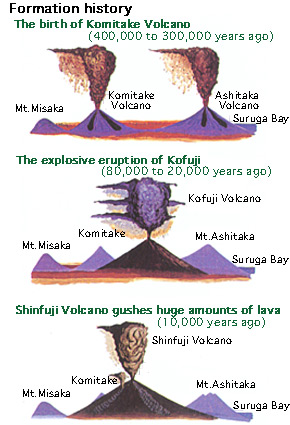As introduced in the introduction, Mount Fuji is the highest mountain in Japan. Not only is it a mountain but also a volcano. Geologists believe that the volcano is still active to this day but the eruption of it is not expected any time soon. Mount Fuji is an example of a triple junction. Triple junction is when three different plate tectonics collide. The three tectonic plates that met each other came from Eurasia, the Philippines, and North America. They were called Amurian plate (Eurasia), Okhotsk plate (North America), lastly Filipino plate.
(Distribution of tectonics plates and active volcanoes around Japan)
(http://www.pref.shizuoka.jp/a_foreign/english/fuji/whatfuji.html)
After the discovery of Mount Fuji’s formation, geologists uncovered the mountain to be a volcano. When Mount Fuji’s magma escape from the Earth’s molten interior it cooled and harden into solid rock which produced the mountain to be coned-shaped also called a stratovolcano. Geologists later figured out that Mount Fuji is a form of basalt-based composite volcano which is a volcano that has accumulated its present form through several successive massive eruptions.
Mount Fuji wasn't just created as one big volcano itself, instead the mountain was made by three generation of volcanic activities. The three volcanoes were called, Ashitakayama/Ko-Mitake (Small Mitake), Ko-Fuji (Old Fuji) and Shin-Fuji (New Fuji) volcanoes. Ko-Mitake was the very first phase of the volcano. This phase was when Mount Fuji was named Ko-Mitake and when the volcano was releasing andesite before basalt. Rocks from the Ko-Mitake volcano are still visible on the northern side of Mount Fuji. The second phase known as Old Fuji erupted about 80,000 years after Ko-Mitake’s eruption. The remaining structure of Old Fuji is located south of Ko-Mitake’s leftovers. Right now Mount Fuji is still in the process of the last volcanic activity that exploded 11,000 years later. Without these three volcanic activities, Mount Fuji would not be the highest mountain in Japan as of today.
(http://www.fujisan-net.gr.jp/english/4_04.htm)
--------------------------------------
References:
http://www.sciences360.com/index.php/the-importance-of-mt-fuji-to-geology-196/
http://legacy.earlham.edu/~steelem/mtfuji.htm
http://freetickettojapan.com/must-see-places-in-japan-for-first-time-visitors/
http://www.pref.shizuoka.jp/a_foreign/english/fuji/whatfuji.html
http://www.fujisan-net.gr.jp/english/4_04.htm

No comments:
Post a Comment